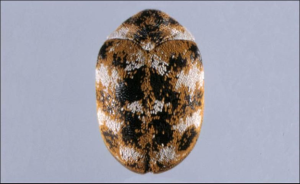They’ve mostly all moved away for now, but every winter and early spring the office gets questions about tiny beetles in homes. These beetles are small with spotty color patterns. The answer is carpet beetles. Carpet may be in their name, but it may not be their favorite spot. Carpet beetles feed on a lot of the same things as clothes moths such as wool, felt, and fur because these materials contain keratin. And their feeding damage is often mistaken for that of clothes moths.
Adult carpet beetles are between 1/16 to 1/8-inch in length. They are oval-shaped and range in color from black to various patterns of white, brown, yellow, and orange. The majority of samples we see are black and white mottled. The adults are often found on windowsills and window stools in the springtime. The larvae conduct all the damage to fabrics and other materials, while the adults stick to feeding on flower pollen. The evidence of feeding can be seen by threadbare spots and irregular holes. Blankets and clothes in storage and carpeted areas under furniture are preferred because they are undisturbed.
As with most insect pests, prevention is the best control for carpet beetles. In addition to feeding on fabrics and material, larvae feed on dust, lint, and animal hair. Frequent cleaning of floors and vacuuming of rugs and carpets eliminates most of the food supply. Stored blankets, clothes, and rugs should be periodically cleaned, brushed, and or sunned. Moth balls can be used at labeled rates but should not be the sole means of control.
For more information on carpet beetles and more detailed prevention and control tactics, please go the University of Florida/IFAS Publication: “Pests in and around the Souther Lawn – Carpet Beetles”.
- Gardening in the Panhandle LIVE! Program Summary: Pests of Florida Lawns and Landscape Plants - May 28, 2025
- Fun Facts About Ferns - April 30, 2025
- Gardening in the Panhandle LIVE! Program Summary: Freeze Friendly Foliage Plants - April 30, 2025

